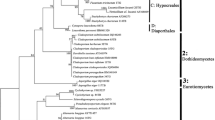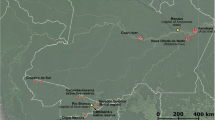Abstract
A systematic study was made of the endophytes of Azadirachta indica A. Juss (the neem tree) growing in several of its natural habitats in India. A total of 233 isolates of endophytic fungi representing 18 fungal taxa were obtained from segments of bark, stem, and leaves of this tree. Hyphomycetes (62.2%) were the most prevalent followed by the Coelomycetes (27.4%) and Mycelia Sterilia (7.7%). As mathematically determined, the maximum species richness and frequency of colonization of endophytes appeared in leaf segments rather than stem and bark tissues from each location. Endophytic colonization frequency was also greater in leaves (45.5%) than bark (31.5%). The leaf samples from all locations were nearly constant in their endophytic composition, whereas bark samples showed maximum diversity at different locations. Inter-site comparisons for endophytic diversity, however, were not significantly different with Loc1 and Loc2 having a maximum of 66.67% J c. The smallest similarity was between Loc2 and Loc3 of 54.17% J c. The dominant endophytic fungi isolated were Phomopsis oblonga, Cladosporium cladosporioides, Pestalotiopsis sp., Trichoderma sp, and Aspergillus sp. Genera such as Periconia, Stenella, and Drechslera are reported here for the first time as endophytes from this host plant. This report illustrates the value of sampling different tissues of a given plant in several locations to obtain the greatest species diversity of endophytes. The rich and sizeable collection of endophytic fungi from this specific plant may represent a unique source of one or more of the interesting and useful bioactive compounds normally associated with A. indica such as the azadirachtins and related tetranortriterpenoids.


Similar content being viewed by others
References
Ainsworth, GC, Sparrow, FK, Sussman, AS (1973) The Fungi—advanced Treaties, Taxonomic Review with Keys (Vol. IV A). Academic Press, New York, USA
Ascher, KRS (1993) Nonconventional insecticidal effects of pesticides available from the neem tree Azadirachta indica. Arch Insect Biochem Physiol 22: 433–449
Barnett, HL, Hunter, BB (1998) Illustrated Genera of Imperfect Fungi. (4th ed.) Mac Millan Publ. Co. ISBN: 0-89054-192-2, New York
Bettucci, L, Saravay, M (1993) Endophytic fungi of Eucalyptus globulus: a preliminary study. Mycol Res 97: 679–682
Bhargava, AK (1989) Neem skinment for the management of wounds. Intern. Conf. Recent Advances Medicinal Aromatic and Spice Crops. Abstract, New Delhi, India, p 65
Bills, GF, Giacobbe, RA, Lee, SH, Pelaez, F, Tracz, JS (1992) Tremorgenic mycotoxins Paspalitrems A and C from tropical Phomopsis. Mycol Res 96: 977–983
Bills, GF, Pollishook, JD (1991) Micro fungi from Carpinus caroliniana. Can J Bot 69: 1477–1482
Bills, GF, Pollishook, JD (1992) Recovery of endophytic fungi from Chamaecyparis thyoides. Sydowia 44: 1–12
Board on Science and Technology for International Development, National Research Council (1992) Report of an Ad Hoc Panel on Neem, A Tree for Solving Global Problems. National Academic Press, Washington DC, pp 60–113
Bunkers, GF, Kenfield, D, Strobel, GA (1991) Production of petasol by Drechslera gigantia in liquid culture. Mycol Res 95: 347–351
Carroll, GC (1995) Forest endophytes: pattern and process. Can J Bot 73(Suppl. 1): S1316–S1324
Collado, J, Platas, G, Paleaz, F (2001) Identification of an endophytic Nodulisporium sp. from Quercus ilex in central Spain as the anamorph of Biscogniauxia mediterranea by rDNA sequence analysis and effect of different ecological factors on distribution of the fungus. Mycologia 93: 875–886
De Bary, A (1866) Morphologie und physiologie der plize, Flechten, und Myxomyceten (Hofmeister’s Hand Book of Physiological Botany. Vol. 2) Leipzig
Dixit, VP, Sinha, R, Tank, R (1986) Effect of neem seed oil on the blood glucose concentration of normal and alloxane diabetic rats. J Ethnopharmacol 17: 95–98
Ekanem, OJ (1978) Has Azadirachta indica (Dogonyaro) any anti-malarial activity. Niger Med J 8: 8–10
Ellis, MB (1971) Dematiaceous Hyphomycetes, Commonwealth Mycological Institute, Kew, Surrey England
Ellis, MB (1976) More Dematiaceous Hyphomycetes, Commonwealth Mycological Institute, Kew, Surrey England
Fisher, PJ, Anson, AE, Petrini, O (1986) Fungal endophytes in Ulex europaeus and U. galli. Trans Br Mycol Soc 86: 153–156
Fisher, PJ, Petrini, LE, Sutton, BC (1995) A study of fungal endophytes from leaves, stem, and root of Gynoxis oleifolia Muchler (Compositae) from Ecuador. Nova Hedwig 60: 589–594
Fisher, PJ, Petrini, O (1990) A comparative study of fungal endophytes in xylem and bark of Alnus sp. in England and Switzerland. Mycol Res 94: 313–319
Fisher, PJ, Petrini, O, Petrini, LE, Sutton, BC (1994) Fungal endophytes from the leaves and twigs of Quercus ilex L from England, Majorca and Switzerland. New Phytol 127: 133–137
Geris dos Santos, RM, Rodrigues, FE, Rocha, WC, Teixeira, MFS (2003) Endophytic fungi from Melia azedarach. World J Microbiol Biotechnol 19: 767–770
Hata, K, Futai, K (1995) Endophytic fungi associated healthy Pine needles and needles infested by Pine needle gall midge Thecodiplosis japonensis. Can J Bot 73: 384–390
Isman, MB, Koul, O, Luczenski, A, Kaminski, Z (1990) Insecticidal and antifeedent bioactivities of neem oils and their relationship to azadirachtin content. J Agric Food Chem 38: 1406–1411
Johnson, GI, Mead, AJ, Cook, AW, Dean, JR (1992) Mango stem and rot pathogens: fruit infection by endophytic colonization of the inflorescence and pedicel. Ann Appl Biol 120: 225–234
Johnson, JA, Whitney, NJ (1994) Cytotoxicity and insecticidal activity of endophytic fungi from Black Spruce (Picea mariana) needles. Can J Microbiol 40: 24–27
Kim, S, Shin, D, Lee, T, Oh, KB (2004) Periconicins, two new fusicoccane diterpenes produced by an endophytic Periconia sp. with anti bacterial activity. J Nat Prod 67: 448–450
Koul, O, Isman, MB, Ketkar, CM (1990) Properties and Uses of neem, Azadirachta indica A Juss. Can J Bot 68: 1–11
Kumaresan, V, Suryanarayanan, TS (2002) Endophytic assemblage in young, mature and senescent roots of Rhizophora apiculata, evidence for the role of endophytes in mangrove litter degradation. Fungal Divers 9: 81–91
Li, JY, Sidhu, RS, Ford, E, Hess, WM, Strobel, GA (1998) The induction of taxol production in the endophytic fungus—Periconia sp. from Torreya grandifolia. J Ind Microbiol 20: 259–264
Lodge, JD, Fisher, PJ, Sutton, BC (1996) Endophytic fungi of Manilkara bidentata leaves in Puerto-Rico. Mycologia 88: 733–738
Mahesh, B, Tejesvi, MV, Nalini, MS, Prakash, HS, Kini, KR, Subbiah, V, Hunthrike, SS (2005) Endophytic mycoflora of inner bark of Azadirachta indica A. Juss. Curr Sci 88: 218–219
Okpanyi, SN, Ezukwk, GC (1981) Anti-inflammatory, and anti-pyretic activities of Azadirachta indica. Planta Med 41: 34–49
Patel, RP, Trivedi, BM (1962) The in vitro antibacterial activity of some medicinal oils. Indian J Med Res 50: 218–222
Pereira, JO, Carneiro Vieira, ML, Azevedo, JL (1999) Endophytic fungi from Musa acuminata and their reintroduction in to axenic plants. World J Microbiol Biotechnol 15: 43–46
Petrini, O, Fisher, PJ (1986) Fungal endophytes in Salicornia perennis. Trans Br Mycol Soc 87: 647–651
Petrini, O, Sieber, TN, Toti, L, Viret, O (1992). Ecology, metabolite production, and substrate utilization in endophytic fungi. Nat Toxins 1: 185–196
Pettit, GR, Barton, HDR, Herald, GL, Polonsky, J, Schmidt, JM, Conolly, JD (1983) Evaluation of Limnoides against murine P-388 lymphocytic leukemia cell line. J Nat Prod 46: 379–390
Pillai, NR, Santhakumari, G (1984b) Toxicity studies on Nimbidine, a potential anti-ulcer drug. Planta Med 50: 146–148
Rajagopal, R, Suryanarayanan, TS (2000) Isolation of endophytic fungi from leaves of neem (Azadirachta indica). Curr Sci 78: 1375–1378
Raper, KB, Thom, CA (1949) A Manual of the Penicillia. Amsterdam. Elsevier Biomedical Press, The Netherlands
Rodrigues, KF (1994) The foliar fungal endophytes of the Amazonian palm Euterpe oleracea. Mycologia 86: 376–385
Rodrigues, KF, Petrini, O (1997) Biodiversity of endophytic fungi in tropical regions. In: Hyde, KD (Ed.) Biodiversity of Tropical Micro-fungi, Hong- Kong University Press, Hong-Kong, pp 57-69
Rodrigues, KF, Samuels, GJ (1999) Fungal endophytes of Spondias mombin leaves in Brazil. J Basic Microbiol 39: 131–135
Roll Hansen, F, Roll Hansen, H (1979) Ascocoryne species in living stems of Picea spp. Eur J For Pathol 5: 275–280
Rollinger, JL, Langenheim, JH (1993) Geographic survey of fungal endophytic community, composition in leaves of coastal redwood. Mycologia 85: 149–156
Schweigkofler, W, Prillinger, M (1997) Analysis of endophytic and latent pathogenic fungi isolated from wooden part of Grape vine Vitis venifera in Australia and South Tryol. Pl Path 47: 149–158
Stierle, A, Strobel, GA, Stierle, D (1993) Taxol and taxane production by Taxomyces andreanae an endophytic fungus of Pacific yew. Science 260: 214–216
Stone, JK, Bacon, CW, White Jr, JF (2000) An overview of endophytic microbes: endophytism defined. In: Bacon, CW, White Jr, JF (eds.) Microbial endophytes, Marcel Dekker, ISBN: 0-824-78831-1, New York, pp 3–29
Strobel, GA, Daisy, B (2003) Bioprospecting for microbial endophytes and their natural products. Microbiol Mol Biol Rev 67: 491–502
Sturz, AV, Nowak, J (2000) Endophytic communities of rhizobacteria and the strategies required creating yield-enhancing associations with crop. Appl Soil Ecol 15: 183–190
Suryanarayanan, TS (1992) Light incubation—a neglected procedure in mycology. Mycologist 6:144
Tejesvi, MV, Mahesh, B, Nalini, MS, Prakash, HS, Kini, KR, Subbiah, V, Hunthrike, SS (2005) Endophytic fungal assemblages from inner bark and twigs of Terminalia arjuna W. & A. (Combretaceae). World J Micro Biotechnol 21:1535–1540
Udeinya, IJ, Mbah, AU, Chijioke, CP, Shu, EN (2004) An antimalarial extract from neem leaves is anti-retroviral. Trans Royal Soc Trop Med Hyg 98:435–437
Whittaker, RH (1972) Evolution and measurement of species diversity. Taxon 12:213–251
Wilson, D (1995) Endophytes—the evolution of a term and clarification of its use and definition. Oikos 73:274–276
Wilson, D, Carroll, GC (1994) Infection studies of Discula quercina, an endophyte of Quercus garryana. Mycologia 86:635–647
Acknowledgements
The authors are thankful to the Head of the Department of Botany, Banaras Hindu University, Varanasi India, for providing the necessary facilities. The authors also extend their thanks to CSIR/UGC, New Delhi for providing financial assistance in the form of JRF/SRF. GAS expresses his appreciation to the Montana Agricultural Experiment Station and the Montana Board of Research and Commercialization Technology for their support of this work.
Author information
Authors and Affiliations
Corresponding author
Rights and permissions
About this article
Cite this article
Verma, V.C., Gond, S.K., Kumar, A. et al. The Endophytic Mycoflora of Bark, Leaf, and Stem Tissues of Azadirachta indica A. Juss (Neem) from Varanasi (India). Microb Ecol 54, 119–125 (2007). https://doi.org/10.1007/s00248-006-9179-9
Received:
Revised:
Accepted:
Published:
Issue Date:
DOI: https://doi.org/10.1007/s00248-006-9179-9




